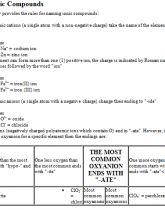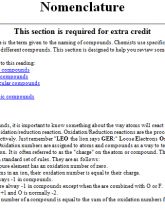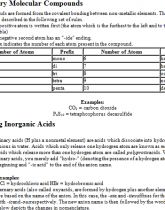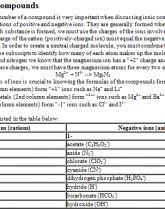Studijní materiál: Nomenclature (Oxidation, Formic Ionic Compounds, Naming...)
Skrýt detaily | Oblíbený- Kvalita:84,9 %
- Typ:Studijní materiál
- Univerzita:Veterinární a farmaceutická univerzita Brno
- Fakulta:Farmaceutická fakulta
- Kategorie:Přírodní vědy
- Podkategorie:Chemie
- Předmět:Chemie přírodních látek
- Autor:stefan.potocky
- Ročník:3. ročník
- Rozsah A4:6 strán
- Zobrazeno:1 552 x
- Stažené:0 x
- Velikost:0,1 MB
- Formát a přípona:MS Office Word (.doc)
- Jazyk:anglický
- ID projektu:5007
- Poslední úprava:09.02.2015
This section is required for extra credit
Chemical nomenclature is the term given to the naming of compounds. Chemists use specific rules and "conventions" to name different compounds. This section is designed to help you review some of those rules and conventions.
There are five sections to this reading:
1. Forming ionic compounds
2. Naming ionic compounds
3. Naming molecular compounds
4. Naming acids
5. Naming organic compounds
Oxidation
When forming compounds, it is important to know something about the way atoms will react with each other. One important hint is the oxidation/reduction reaction. Oxidation/Reduction reactions are the processes of losing and gaining electrons respectively. Just remember "LEO the lion says GER:" Loose Electrons Oxidation, Gain Electrons Reduction. Oxidation numbers are assigned to atoms and compounds as a way to tell scientists where the electrons are in a reaction. It is often referred to as the "charge" on the atom or compound. The oxidation number is assigned according to a standard set of rules.
They are as follows:
1. An atom of a pure element has an oxidation number of zero.
2. For single atoms in an ion, their oxidation number is equal to their charge.
3. Fluorine is always -1 in compounds.
4. Cl, Br, and I are alway -1 in compounds except when the are combined with O or F.
5. H is normally +1 and O is normally -2.
6. The oxidation number of a compound is equal to the sum of the oxidation numbers for each atom in the compound.
Chemical nomenclature is the term given to the naming of compounds. Chemists use specific rules and "conventions" to name different compounds. This section is designed to help you review some of those rules and conventions.
There are five sections to this reading:
1. Forming ionic compounds
2. Naming ionic compounds
3. Naming molecular compounds
4. Naming acids
5. Naming organic compounds
Oxidation
When forming compounds, it is important to know something about the way atoms will react with each other. One important hint is the oxidation/reduction reaction. Oxidation/Reduction reactions are the processes of losing and gaining electrons respectively. Just remember "LEO the lion says GER:" Loose Electrons Oxidation, Gain Electrons Reduction. Oxidation numbers are assigned to atoms and compounds as a way to tell scientists where the electrons are in a reaction. It is often referred to as the "charge" on the atom or compound. The oxidation number is assigned according to a standard set of rules.
They are as follows:
1. An atom of a pure element has an oxidation number of zero.
2. For single atoms in an ion, their oxidation number is equal to their charge.
3. Fluorine is always -1 in compounds.
4. Cl, Br, and I are alway -1 in compounds except when the are combined with O or F.
5. H is normally +1 and O is normally -2.
6. The oxidation number of a compound is equal to the sum of the oxidation numbers for each atom in the compound.




